
During the industrial revolution, cities became hotbeds of disease and other major health risks as high population density, lack of proper sanitation, and pollution contributed to poor health in urban centers. While the trend of urbanization has continued since, health outcomes among city dwellers have steadily improved. Today, cities in the developed world are some of the healthiest places to live.
Many recent studies have highlighted the unique health benefits of living in urban environments. Residents of dense, walkable neighborhoods tend to exercise more and have a lower body mass index. Additionally, cities in the developed world tend to have more access to fresh, healthy foods; they are safer; and have greater access to health care.
City dwellers also face particular health risks, such as air pollution, exposure to disease, and health problems associated with overcrowding. Metropolitan areas that leverage their unique health advantages and mitigate against urban health risks are like to have some of the lowest infant mortality, longest life expectancy, and least exposure to air pollution in the world.
To determine the healthiest cities in the world, 24/7 Wall St. compiled an index of three health outcomes and factors — infant mortality, life expectancy, and exposure to air pollution — with data from the Centers for Disease Control and Prevention, Statistics Canada, the Statistics Bureau of Japan, the World Bank, and the Organisation for Economic Co-operation and Development Metropolitan Areas Database.
Click here to see the healthiest cities in the world.
Click here to see our detailed findings and methodology.

25. Vancouver, Canada
> Population: 2.5 million
> Infant mortality rate: 3.6 deaths per 1,000 live births
> Exposure to air pollution: 6.4 micrograms per cubic meter
> Country life expectancy: 82.3 years
Vancouver has a strong health and wellness culture and is home to active lifestyle brands such as lululemon, Arc’teryx, and Herschel Supply Company. Vancouver also has one of the lowest infant mortality rates in North America.
While Vancouver is the most densely populated city in Canada, it is far from the most polluted. Vancouver residents are exposed to an estimated 6.4 micrograms of pollutant per cubic meter of air, among the least of any Canadian city. Vancouver also has some 99 square meters of green space per resident, or about 10 times the WHO recommendation of 9.5 square meters per capita.
[in-text-ad]

24. Tokushima, Japan
> Population: 557,512
> Infant mortality rate: 2.7 deaths per 1,000 live births
> Exposure to air pollution: 13.1 micrograms per cubic meter
> Country life expectancy: 84.0 years
Located on the eastern shore of Shikoku, the smallest of Japan’s four main islands, Tokushima is one of many cities in Japan to rank among the healthiest in the world. At 84 years, Japan’s life expectancy is the longest of any country. In Tokushima, the infant mortality rate is 2.7 deaths per 1,000 live births, one of the lowest of any city in the world.
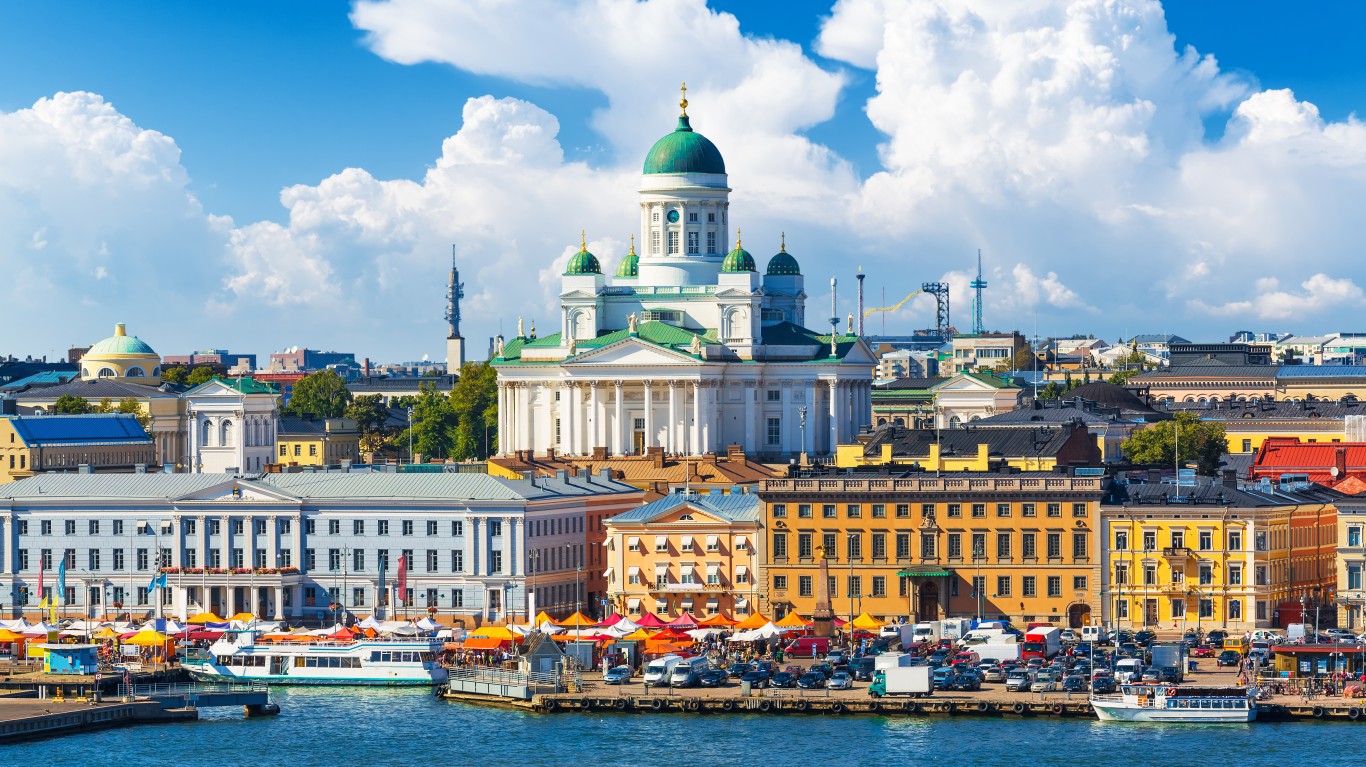
23. Helsinki, Finland
> Population: 1.5 million
> Infant mortality rate: 2.0 deaths per 1,000 live births
> Exposure to air pollution: 7.8 micrograms per cubic meter
> Country life expectancy: 81.8 years
Helsinki has one of the most comprehensive public transit systems in the world, which likely reduces inactivity and contributes to overall well-being in the city. An estimated 93% of Helsinki residents are very satisfied with public transit in the metro area, the third largest share of any European city. Helsinki also has one of the lowest infant mortality rates in the world and some of the cleanest air of any major metropolitan area.

22. Dublin, Ireland
> Population: 1.8 million
> Infant mortality rate: 3.0 deaths per 1,000 live births
> Exposure to air pollution: 4.8 micrograms per cubic meter
> Country life expectancy: 81.6 years
Dublin is the capital of and largest city in Ireland. It is also one of the healthiest cities worldwide. Dublin has a comprehensive transit system and is relatively walkable, which likely helps residents remain physically active. Ireland also has a universal health care system, which reduces the financial burden of medical service on residents and increases the likelihood they will receive medical treatment and preventative care. While Dublin is home to heavy industry operations and has some of the most CO2 emissions per capita of any major city, the estimated exposure to air pollution of just 4.8 micrograms per cubic meter is nearly the lowest of any city in the OECD.
[in-text-ad-2]

21. Madrid, Spain
> Population: 7.1 million
> Infant mortality rate: 3.0 deaths per 1,000 live births
> Exposure to air pollution: 8.3 micrograms per cubic meter
> Country life expectancy: 82.8 years
Madrid is one of four cities in Spain to rank among the world’s 25 healthiest cities. Life expectancy at birth in Spain is 82.8 years, the third longest of any OECD nation after Switzerland and Japan. Madrid is particularly notable for its urban parks and green spaces. The city recently completed construction on Madrid Río, a park that transformed a neglected stretch of highway in the city center into a green space with numerous leisure amenities and 17 play areas that cater to different levels of physical fitness. Today, some 35% of Madrid is green space, one of the largest shares of any major city.

20. Toulon, France
> Population: 561,322
> Infant mortality rate: 2.4 deaths per 1,000 live births
> Exposure to air pollution: 7.9 micrograms per cubic meter
> Country life expectancy: 82.3 years
Located in southern France on the Mediterranean coast, Toulon ranks as the healthiest city in France and one of the healthiest in the world. There are 2.4 infant deaths per 1,000 live births in Toulon, the 13th lowest infant mortality rate of any OECD city in Europe. One factor contributing to positive health outcomes in Toulon may be the city’s Mediterranean climate and strong sunshine. Toulon records an average of 166 days of strong sun per year, the second most of any city in France and among the most of any OECD metropolitan area.
[in-text-ad]
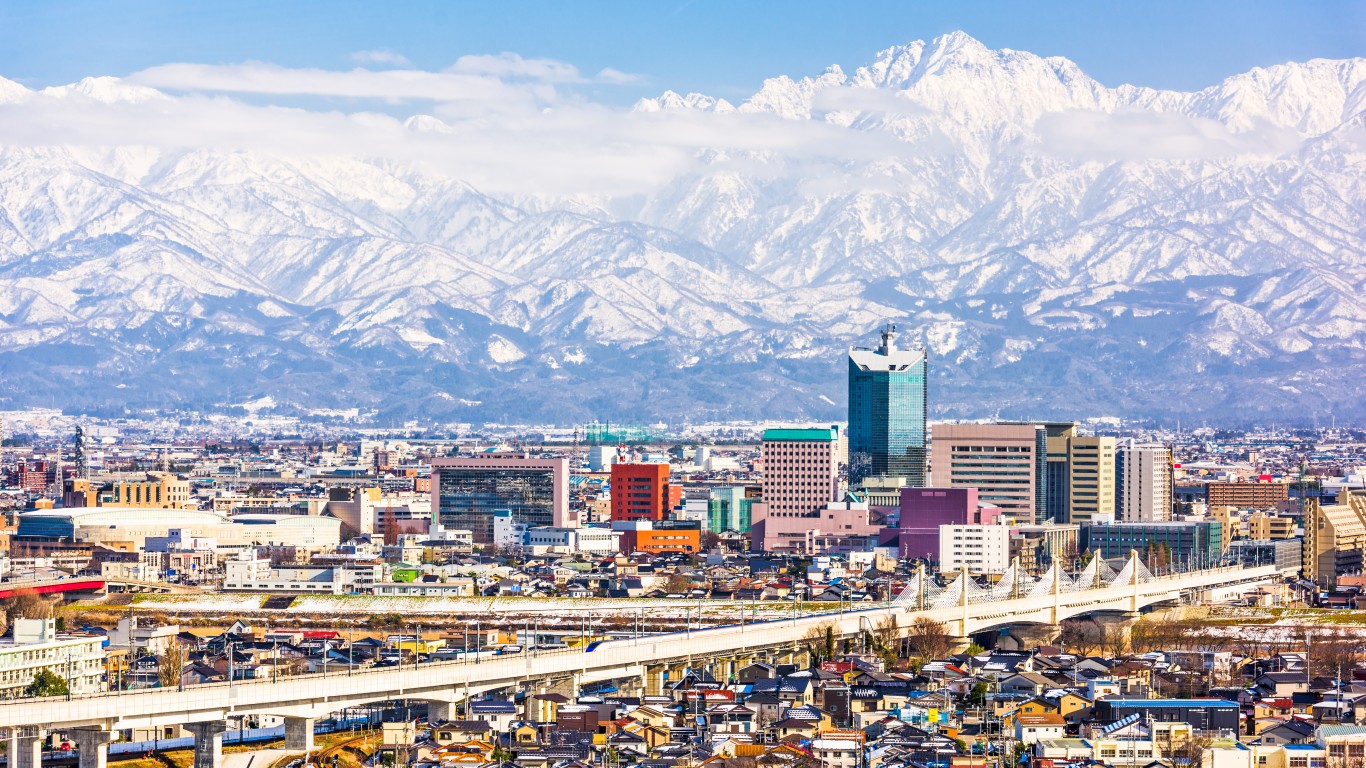
19. Toyama, Japan
> Population: 543,730
> Infant mortality rate: 1.8 deaths per 1,000 live births
> Exposure to air pollution: 14.4 micrograms per cubic meter
> Country life expectancy: 84.0 years
Toyama is one of 13 cities in Japan to rank among the world’s 25 healthiest. Japan’s life expectancy at birth of 84 years is the highest of any OECD country, and Toyama’s infant mortality rate of 1.8 deaths per 1,000 live births is the 11th lowest of any city worldwide.
Toyama is particularly notable for its efforts to reduce greenhouse gas emissions. In recent years, Toyama has revitalized its public transit system by adding new lines and increasing connections between existing lines, ultimately reducing residents’ dependency on automobiles and increasing the number of people concentrated in the city center. Toyama was designated as an “Environmental Model City” by Japan in 2008, and was one of five cities worldwide to be recognized for its advanced “Compact City” policies by the OECD in 2012.

18. Seville, Spain
> Population: 1.5 million
> Infant mortality rate: 3.3 deaths per 1,000 live births
> Exposure to air pollution: 7.1 micrograms per cubic meter
> Country life expectancy: 82.8 years
Seville is one of four cities in Spain to rank among the 25 healthiest in the world. The life expectancy at birth in Spain is 82.8 years, the third longest of any OECD country after Switzerland and Japan. Seville is particularly notable for the success of its community bicycle sharing program. Since Seville introduced its Sevici bike sharing service in 2007, the number of daily bicycle trips in the city has increased more than tenfold from 6,000 to 70,000. The share of residents who commute to work using a bike increased by a similar magnitude, which helps residents remain physically active and reduces automobile dependency in the city and ultimately the pollution associated with driving. Seville residents are exposed to an estimated 7.1 micrograms of air pollutant per cubic meter, among the cleanest air of any city worldwide.

17. Okayama, Japan
> Population: 891,180
> Infant mortality rate: 1.7 deaths per 1,000 live births
> Exposure to air pollution: 14.2 micrograms per cubic meter
> Country life expectancy: 84.0 years
Located in the western end of Honshu, Japan’s largest island, Okayama is one of 13 metropolitan areas in the country to rank among the world’s 25 healthiest cities. Life expectancy at birth in Japan is 84 years, the longest of any OECD nation. There are 1.7 infant deaths on average per 1,000 live births in Okayama each year, the fifth lowest infant mortality rate of any city in the world.
[in-text-ad-2]
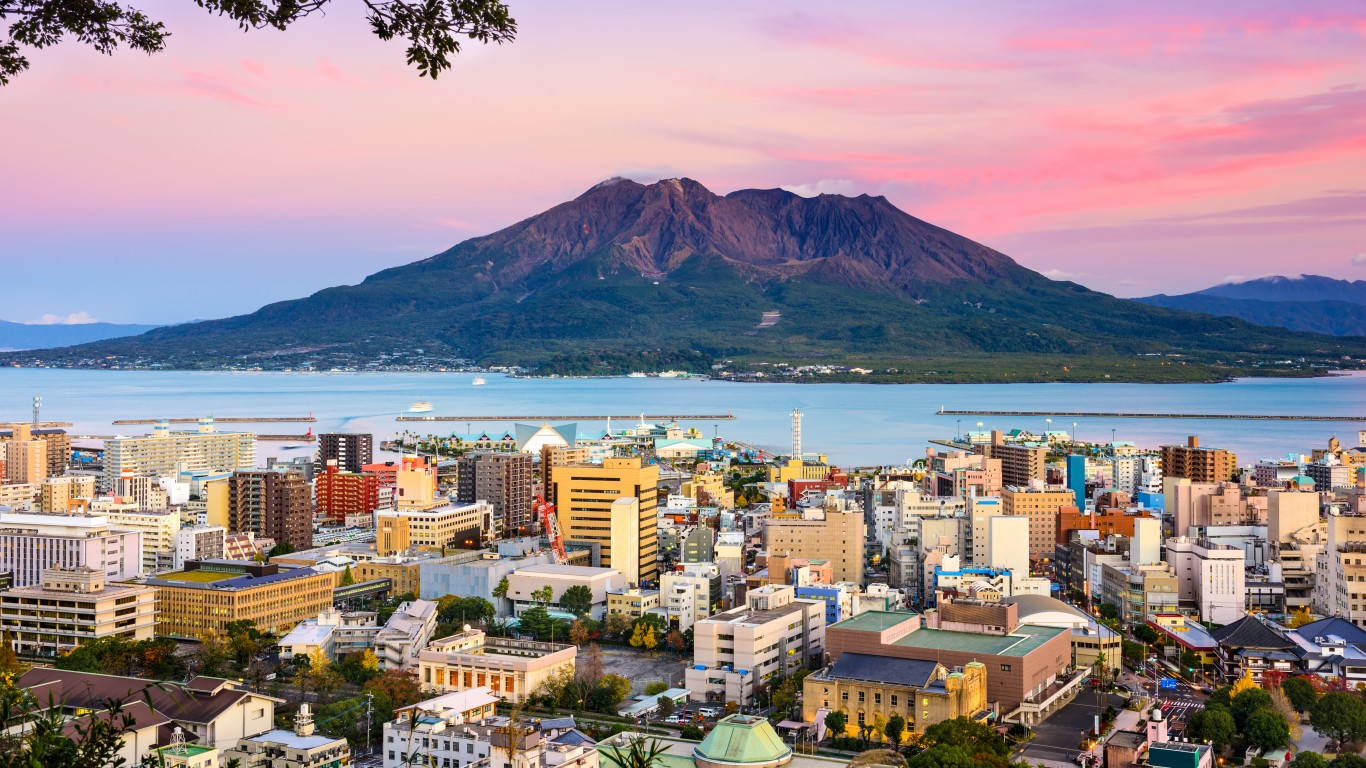
16. Kagoshima, Japan
> Population: 703,839
> Infant mortality rate: 2.5 deaths per 1,000 live births
> Exposure to air pollution: 12.1 micrograms per cubic meter
> Country life expectancy: 84.0 years
Located in the southern tip of Japan’s Kyushu island, Kagoshima is one of the 13 Japanese metropolitan areas that rank among the world’s 25 healthiest cities. Life expectancy at birth in Japan is 84 years, the longest of any OECD nation. Kagoshima is particularly notable for its healthy local cuisine. Popular dishes include the Kagoshima Black Berkshire Pork, kibinago sashimi made from silver-stripe round herring and torisashi sashimi made from raw chicken.

15. Oita, Japan
> Population: 556,647
> Infant mortality rate: 2.1 deaths per 1,000 live births
> Exposure to air pollution: 12.6 micrograms per cubic meter
> Country life expectancy: 84.0 years
Oita is located in the northeastern corner of the Japanese island of Kyushu and ranks as the ninth healthiest city in Japan and the 15th healthiest in the world. The city’s infant mortality rate of 2.1 deaths per 1,000 live births is among the least of any OECD metropolitan area. Healthy lifestyles in Oita are likely facilitated in part by the city’s plentiful green space. Oita has 60.2 square meters of green space per resident, more than six times the 9.5 square meters recommended by the World Health Organization.
[in-text-ad]

14. Stockholm, Sweden
> Population: 2.0 million
> Infant mortality rate: 2.0 deaths per 1,000 live births
> Exposure to air pollution: 7.0 micrograms per cubic meter
> Country life expectancy: 82.2 years
There are 2.0 infant deaths on average per 1,000 live births in Stockholm, the sixth lowest infant mortality rate of any OECD city in Europe. Positive health outcomes in Stockholm may be partially due to the city’s monumental efforts to reduce greenhouse gas emissions and pollution. Some 80% of heating needs in Stockholm are covered by district heating — a more carbon neutral alternative to electric heating — and the city has installed approximately 13,500 solar cells on rooftops throughout the metro area, expecting solar energy to represent 10% of all electricity production by 2040. Residents are exposed to just 7.0 micrograms of pollutant per cubic meter of air, among the least of any city in the world.

13. Gold Coast, Australia
> Population: 560,266
> Infant mortality rate: 4.4 deaths per 1,000 live births
> Exposure to air pollution: 2.0 micrograms per cubic meter
> Country life expectancy: 82.5 years
Gold Coast’s infant mortality rate of 4.4 deaths per 1,000 live births is relatively high compared to other cities on this list. However, the city has some of the cleanest air on Earth. Residents are exposed to an average of 2.0 micrograms of air pollutant per cubic meter of air, tied with Valparaíso, Chile as the least of any metropolitan area in the OECD.
Life expectancy at birth is 82.5 years in Australia , nearly four years longer than life expectancy in the United States.
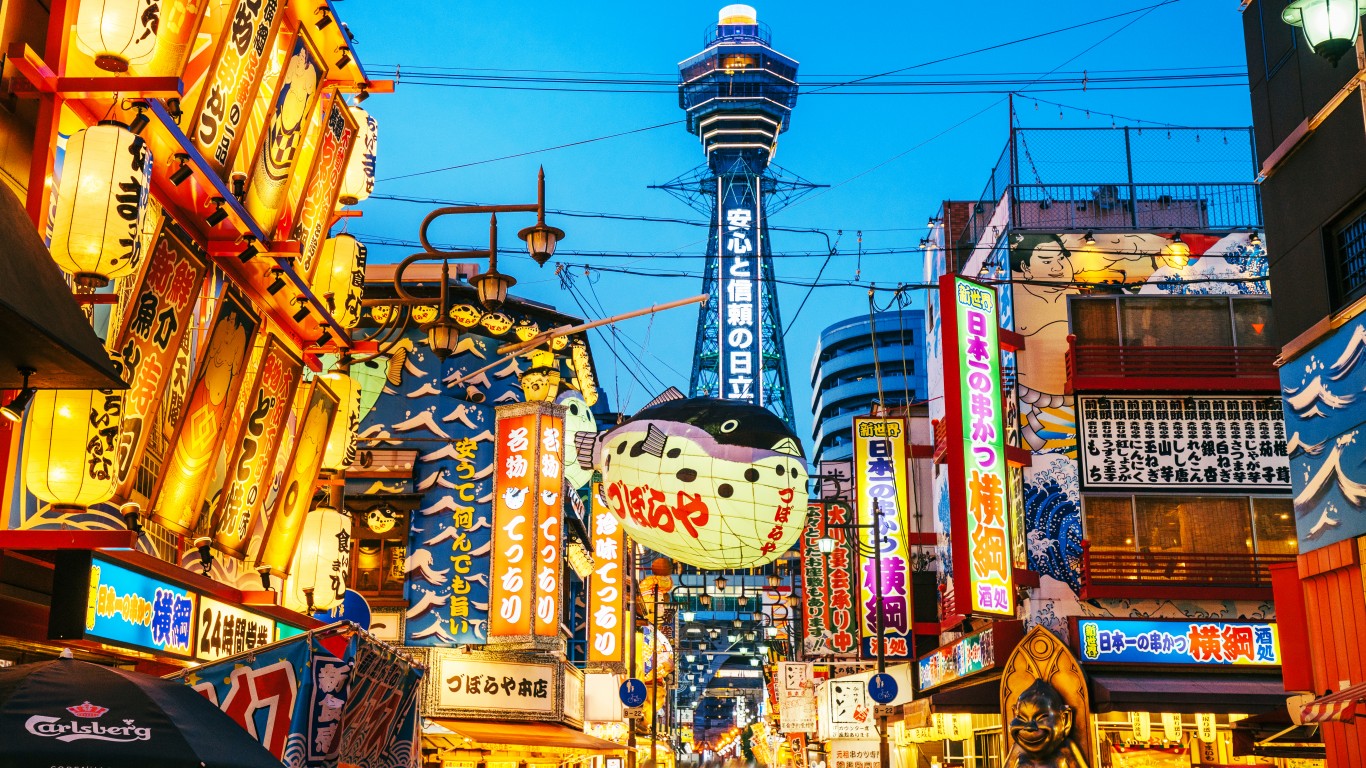
12. Osaka, Japan
> Population: 17.3 million
> Infant mortality rate: 1.7 deaths per 1,000 live births
> Exposure to air pollution: 12.5 micrograms per cubic meter
> Country life expectancy: 84.0 years
Home to 17.3 million residents, Osaka is one of the largest metropolitan areas in Japan and one of the largest cities worldwide. It is one of the 13 cities in Japan to rank among the 25 healthiest on the planet. Japan’s life expectancy at birth of 84 years is the longest of any country. In Osaka, there are 1.7 infant deaths per 1,000 live births, the fourth lowest infant mortality rate of any OECD city.
[in-text-ad-2]
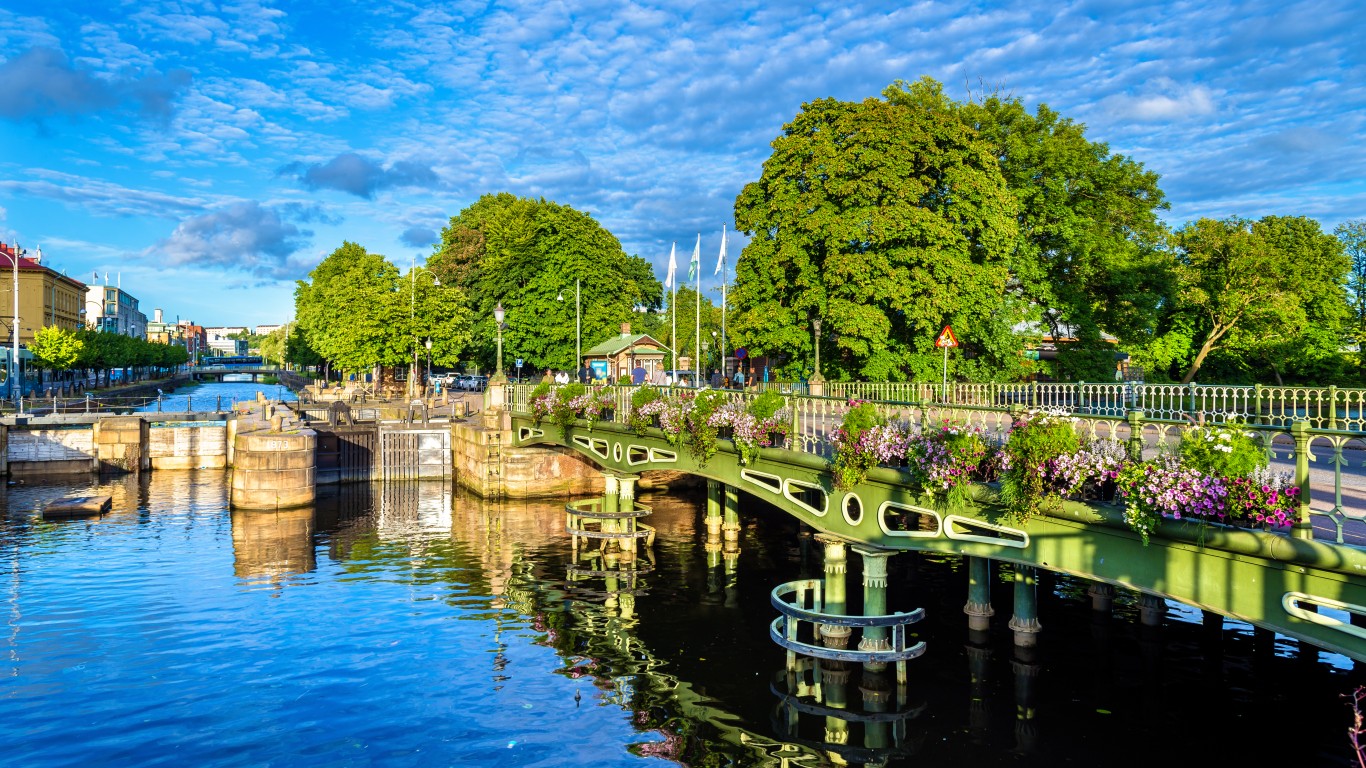
11. Gothenburg, Sweden
> Population: 898,541
> Infant mortality rate: 1.8 deaths per 1,000 live births
> Exposure to air pollution: 6.6 micrograms per cubic meter
> Country life expectancy: 82.2 years
In Gothenburg there are 1.8 infant deaths per 1,000 live births on average, the third lowest infant mortality rate of any city in Europe and among the lowest worldwide. Positive health outcomes in Gothenburg are likely bolstered in part by the city’s commitment to reducing greenhouse gas emissions and pollution. Some 90% of Gothenburg apartment blocks are heated by district heating — a more carbon neutral alternative to electric or oil heating — one of the largest shares of any city. Residents are exposed to an average of 6.6 micrograms of air pollutant per cubic meter of air, among the least of any metropolitan area worldwide.

10. Kochi, Japan
> Population: 487,693
> Infant mortality rate: 1.7 deaths per 1,000 live births
> Exposure to air pollution: 12.0 micrograms per cubic meter
> Country life expectancy: 84.0 years
Located on the southern coast of Japan’s Shikoku island, Kochi is one of 13 cities in Japan to rank among the 25 healthiest in the world. Japan’s life expectancy at birth of 84 years is the longest of any country, and Kochi’s infant mortality rate of 1.7 deaths per 1,000 live births is the seventh lowest of any major city. Kochi’s positive health outcomes are likely made possible in part by the country’s universal health care system and the numerous opportunities for physical activity available throughout the city’s mountains, rivers, and Pacific beaches.
[in-text-ad]

9. Oslo, Norway
> Population: 1.3 million
> Infant mortality rate: 2.5 deaths per 1,000 live births
> Exposure to air pollution: 5.6 micrograms per cubic meter
> Country life expectancy: 82.5 years
Oslo’s infant mortality rate of 2.5 infant deaths per 1,000 live births is one of the lowest in Europe and the world. Positive health outcomes in Oslo are likely due in part to the city’s commitment to reducing its carbon footprint. In recent years, Oslo has crafted strategies aimed at reducing the city’s use of automobiles, such as traffic tolls and auto free zones, and it plans to completely ban cars from the city center by 2019. Reduced automobile activity has likely helped keep the city’s air clean and its residents active. Residents of Oslo are exposed to just 5.6 micrograms of air pollutant per cubic meter of air, some of the cleanest air of any OECD metropolitan area.

8. Hiroshima, Japan
> Population: 1.4 million
> Infant mortality rate: 2.1 deaths per 1,000 live births
> Exposure to air pollution: 10.7 micrograms per cubic meter
> Country life expectancy: 84.0 years
While Hiroshima was devastated when the United States detonated an atomic bomb over the city during World War II in 1945, the city has experienced rapid economic growth over the past 70 years. Today, despite long time concerns of lingering radiation effects, it is one of the healthiest cities in the world. There are 2.1 infant deaths on average per 1,000 live births, one of the lowest infant mortality rates in the world. Hiroshima is one of 13 metropolitan areas in Japan — where the life expectancy at birth of 84 years is the longest of any country — to rank among the world’s 25 healthiest cities.

7. Las Palmas, Spain
> Population: 683,159
> Infant mortality rate: 2.4 deaths per 1,000 live births
> Exposure to air pollution: 6.2 micrograms per cubic meter
> Country life expectancy: 82.8 years
Las Palmas is one of four metropolitan areas in Spain to rank among the 25 healthiest cities in the world. There are 2.4 infant deaths on average per 1,000 live births in Las Palmas, one of the lowest infant mortality rates in the world. Las Palmas has a tropical desert climate that is kept cool during the summer by trade winds blowing from the Sahara Desert, which allows residents to comfortably engage in outdoor recreation throughout the year. According to a 1996 study by Syracuse University climatologist Thomas Whitmore, Las Palmas has the best climate of any city on the planet.
[in-text-ad-2]
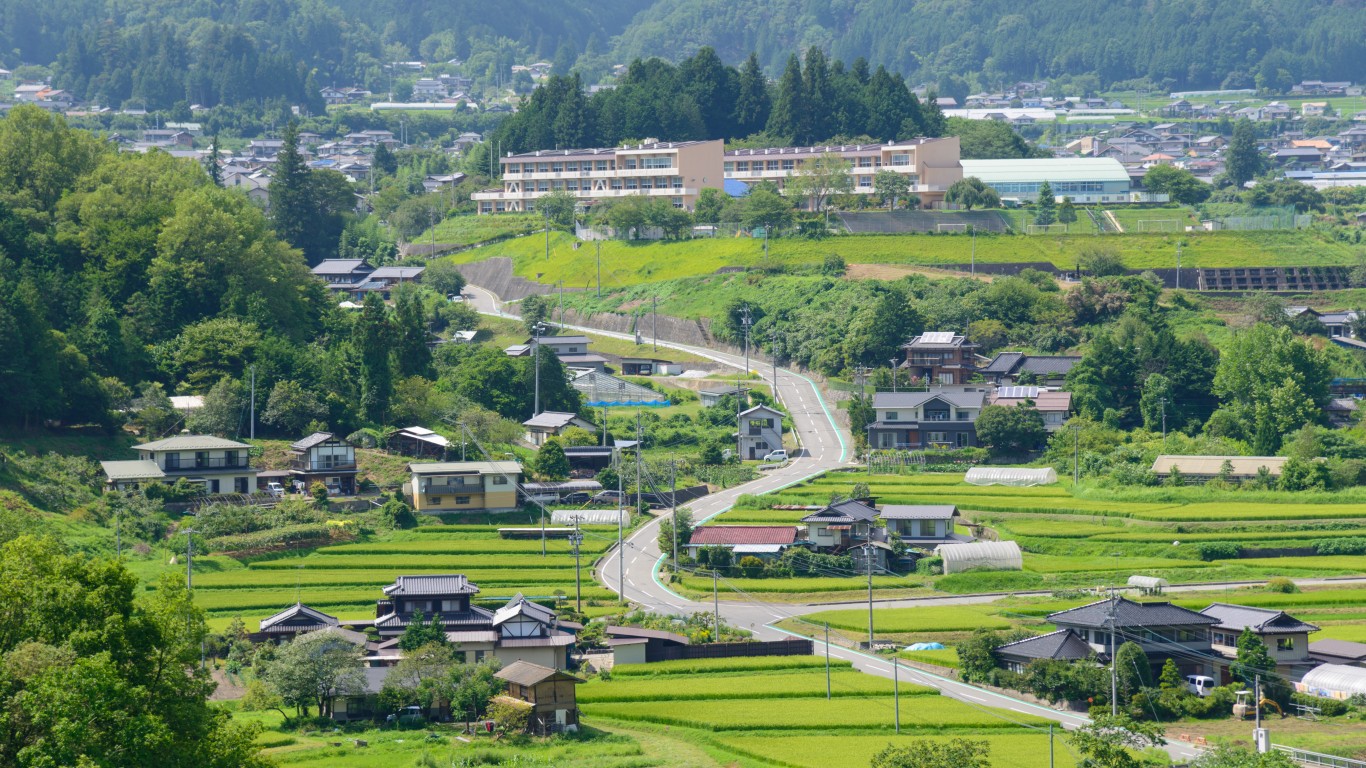
6. Nagano, Japan
> Population: 533,018
> Infant mortality rate: 1.6 deaths per 1,000 live births
> Exposure to air pollution: 11.5 micrograms per cubic meter
> Country life expectancy: 84.0 years
Located inland on the Japanese island of Honshu, Nagano is one of 13 metropolitan areas in Japan to rank among the 25 healthiest cities in the world. Life expectancy at birth in Japan is 84 years, the highest of any country and more than five years longer than the U.S. life expectancy. In Nagano, there are 1.6 infant deaths on average per 1,000 live births, the least of any major metro area on the planet other than Kumamoto, Japan. Japan’s universal health care system and large amount of green space likely contribute to the positive health outcomes in Nagano. There are some 255 square meters of green space per Nagano resident, more than 26 times the WHO recommendation of 9.5 square meters per capita.

5. Nagasaki, Japan
> Population: 508,050
> Infant mortality rate: 1.7 deaths per 1,000 live births
> Exposure to air pollution: 10.8 micrograms per cubic meter
> Country life expectancy: 84.0 years
Nagasaki was devastated when the United States detonated a nuclear bomb over the city in 1945 — an estimated 75,000 people were killed or wounded instantly and 23% of the city’s buildings were destroyed. However, the metropolitan area has experienced substantial economic growth since World War II and, despite long time concerns of lingering radiation effects, is one of the healthiest cities in the world today. There are 1.7 infant deaths per 1,000 live births in Nagasaki, the eighth lowest infant mortality rate of any major city.
[in-text-ad]

4. Wakayama, Japan
> Population: 521,972
> Infant mortality rate: 1.8 deaths per 1,000 live births
> Exposure to air pollution: 10.5 micrograms per cubic meter
> Country life expectancy: 84.0 years
Located on the southern tip of the Kii Peninsula of Honshu island, Wakayama is one of 13 Japanese metropolitan areas to rank among the 25 healthiest cities in the world. Life expectancy at birth in Japan is 84 years, the highest of any OECD nation and more than five years longer than U.S. life expectancy. There are 1.8 infant deaths per 1,000 live births in Wakayama, one of the lowest infant mortality rates on the planet.

3. Bilbao, Spain
> Population: 1.0 million
> Infant mortality rate: 2.8 deaths per 1,000 live births
> Exposure to air pollution: 4.4 micrograms per cubic meter
> Country life expectancy: 82.8 years
Over the past 25 years, Bilbao has undergone rapid transformation from an industrial economy centered on its port to a service-oriented economy and international business hub. Major urban renewal steps included the modernization of the city’s public transit system, the rehabilitation of blighted industrial areas, and the commissioning of projects by some of the world’s most prominent architects. Today, the city ranks as the healthiest metropolitan area in Europe and the third healthiest worldwide. One factor that promotes good health in Bilbao is the city’s commitment to reducing air pollution. Residents are exposed to just 4.4 micrograms of pollutant per cubic meter of air, ranking the city’s air among the cleanest worldwide.

2. Niigata, Japan
> Population: 1.0 million
> Infant mortality rate: 1.7 deaths per 1,000 live births
> Exposure to air pollution: 10.4 micrograms per cubic meter
> Country life expectancy: 84.0 years
Located on the west coast of Japan’s Honshu island, Niigata ranks as the second healthiest metropolitan area in the world. It is one of 13 cities in Japan — where the life expectancy at birth of 84 years is the longest of any country — to rank among the 25 healthiest cities in the world. There are 1.7 infant deaths per 1,000 live births in Niigata, the third lowest infant mortality rate of any major city worldwide. The positive health outcomes in Niigata and other Japanese cities are likely facilitated by the country’s universal health care system, which can reduce the financial burdens of receiving medical treatment and increases the likelihood of people obtaining medical and preventative care.
[in-text-ad-2]

1. Shizuoka, Japan
> Population: 731,863
> Infant mortality rate: 1.8 deaths per 1,000 live births
> Exposure to air pollution: 9.9 micrograms per cubic meter
> Country life expectancy: 84.0 years
Located on the southern coast of Japan’s Honshu island, Shizuoka ranks as the healthiest city on the planet. Life expectancy in Japan is 84 years, the longest of any country, and there are 1.8 infant deaths per 1,000 live births in Shizuoka, one of the lowest infant mortality rates in the world. The Shizuoka prefecture also has the longest healthy life expectancy in Japan. Positive health outcomes in Shizuoka are likely in part facilitated by Japan’s universal health care system as well as local access to healthy foods. The Japanese diet, characterized by a high intake of fish and soybean products and an emphasis on fresh, seasonal food, is one of the main factors responsible for the country’s long life expectancy. Shizuoka is the country’s leading producer of green tea, wasabi, and tuna — three staples in Japanese cuisine.
Detailed Findings
The policies of city governments and urban planning departments can have a significant impact on public health outcomes. Cities tend to generate more pollution than rural areas, and higher pollution can have negative health consequences for residents. In recent decades, many cities have adopted sustainability strategies aimed at reducing environmental hazards. Such strategies include increasing the amount of green space and adding recycling programs that ultimately reduce air pollution. Many of the cities with the lowest infant mortality rates have relatively low estimated exposure to air pollution and large amounts of green space per capita.
In addition to alleviating many of the environmental risks associated with density in urban areas, cities can promote public health by encouraging citizens to be more active. Cities that are successful in creating active environments often create opportunities for residents to engage in physical activity in their day-to-day routines. One important factor is creating venues for physical activity that engage both active and less active residents. Examples include wide bike lanes that allow for safe cycling, public transit that allows for citizens to live without a car, and urban green spaces that promote activity.
Another factor that can promote public health is universal health care. Universal access to quality medical services, health workers, medicine, and technology can reduce the financial burden on residents seeking medical care and increase the likelihood that citizens will seek preventative care. All of the world’s 25 healthiest cities are in countries with universal health care systems.
Of the 25 healthiest cities, 13 are in Japan. Life expectancy at birth in Japan is 84 years, the highest of any country. Positive health outcomes in Japan are due to a number of factors, including healthy cultural habits, successful implementation of numerous health innovations, and a strong universal health care system.
One of the other factors contributing to health in Japan is the country’s strong post-World War II economic growth. While good government policy and green space can promote health and wellness, economic prosperity is also a vital component of public health. In 19 of the 20 healthiest cities with available data, the estimated annual household disposable income is above the median among OECD countries of $20,400.
Methodology
To determine the healthiest cities in the world, 24/7 Wall St. compiled an index of three health outcomes and factors — infant mortality, life expectancy, and exposure to air pollution. Data on infant mortality came from the Centers for Disease Control and Prevention, Eurostat, Statistics Canada, and the Statistics Bureau of Japan. Infant mortality data for U.S. and European metro areas are for the period 2007 to 2016. Infant mortality data for cities in Canada and Australia are for the period 2010 to 2012, and infant mortality data for prefectures in Japan are for the period 2015 to 2016. Data on life expectancy at birth at the country level are from the World Bank and are for 2016. Data on estimated exposure to air pollution, square meters of green area per resident, population, and equivalised disposable income came from the Organisation for Economic Co-operation and Development Metropolitan Areas Database. All data are for the most recent period available.
Are You Still Paying With a Debit Card?
The average American spends $17,274 on debit cards a year, and it’s a HUGE mistake. First, debit cards don’t have the same fraud protections as credit cards. Once your money is gone, it’s gone. But more importantly you can actually get something back from this spending every time you swipe.
Issuers are handing out wild bonuses right now. With some you can earn up to 5% back on every purchase. That’s like getting a 5% discount on everything you buy!
Our top pick is kind of hard to imagine. Not only does it pay up to 5% back, it also includes a $200 cash back reward in the first six months, a 0% intro APR, and…. $0 annual fee. It’s quite literally free money for any one that uses a card regularly. Click here to learn more!
Flywheel Publishing has partnered with CardRatings to provide coverage of credit card products. Flywheel Publishing and CardRatings may receive a commission from card issuers.
Thank you for reading! Have some feedback for us?
Contact the 24/7 Wall St. editorial team.
 24/7 Wall St.
24/7 Wall St. 24/7 Wall St.
24/7 Wall St. 24/7 Wall St.
24/7 Wall St. 24/7 Wall St.
24/7 Wall St.



